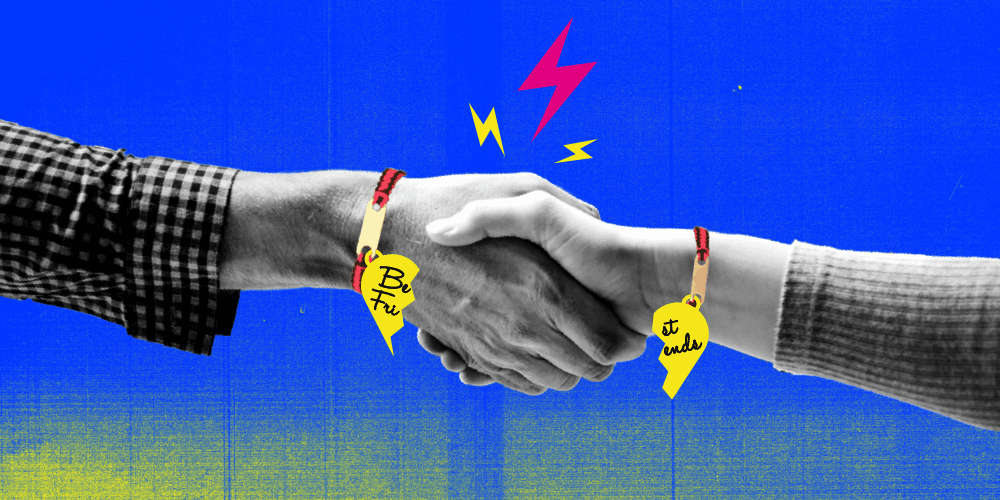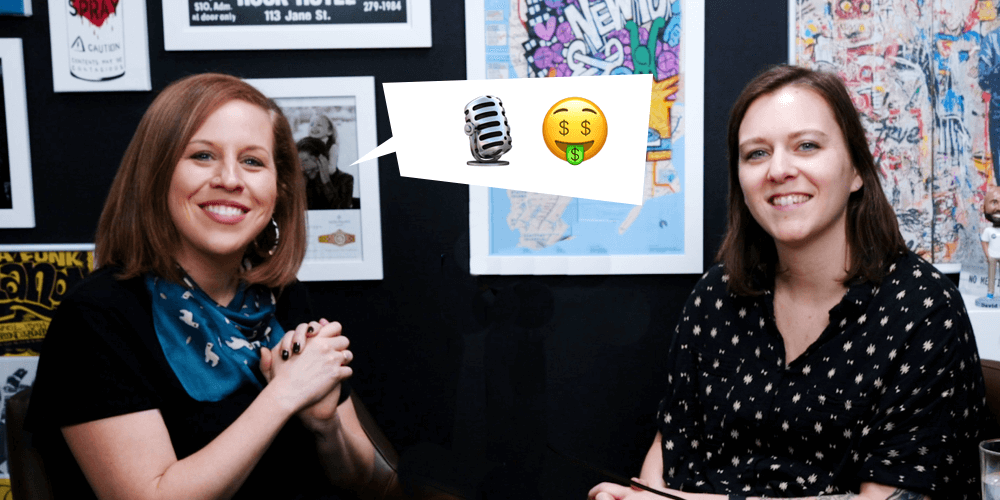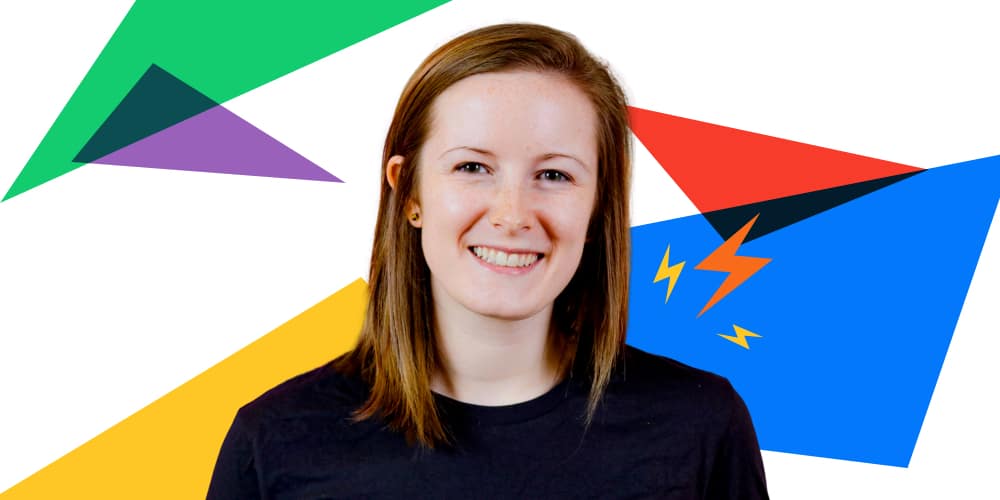
I don’t record LinkedIn videos, host webinars, or send out emails, but you can find traces of me scattered throughout all those things and on our website, social promos, event signage, ad campaigns, etc. Normally I don’t write blogs either, but there’s a first time for everything.
My name’s Michelle, and I’m the marketing designer at Drift.
I turn serial killer drawings of smiley stick figures given to me by idea-crazed, black hoodie wearing, off-the-walls marketers into live, converting pages.
From this:

To this:

When you think of the relationship between marketers and sales reps working with designers, it’s usually… not always picture-perfect (or as I would say – pixel-perfect). So why do we have a gap between us? It might be because of this tweet…
Okay jokes aside ?
It’s because we think differently – we have different motives. The marketer is driven by capturing qualified leads with content, webinars, email, etc. They dream about sugar plums, funnels, and paragraph-long headlines. And sales is driven to help prospects and convert leads to successful buyers. They communicate with conversations, we communicate with visuals.
Designers communicate by using imagery, color, and composition. Our metrics aren’t MQAs, meetings booked, MRR, or pipeline (though we do have a part in that too). A designer’s “conversion” is attention. Did we grab a potential customer’s attention long enough for them to understand the deal, value, or insights? Everyone’s eye is attracted to shiny objects. We provide that shiny object showcasing that content and customer value.
I’m here to give my advice for working with designers in-house at a growing company. (Side note. It is a very different process when working with an outside creative agency. That’s a whole other blog post!)
When in doubt, remember: the designer’s role is to support marketers and sales in their goals…but within reason. For example, Data Dan wants to run paid ads for a product feature. He provides 50 words of product-heavy language with lots of jargon and acronyms. Not only will the ad-exchange reject those text heavy ads, but visually it won’t work or fit in a 300×250 standard banner ad. With a critical eye and mind, your designer could recommend creating a dynamic GIF that’s bold and eye-catching with a few words for each moving frame.
If sales and marketing want to be successful in their efforts, bring design and creative to the table at the beginning of the process.
We aren’t decorators. We know we only have a split second opportunity to engage a viewer’s mind. A visual component, whether graphic, photo, or video, is more compelling and effective to grab attention – given this crazy, crowded market. Don’t take our word for it? 3M, in a research study, found that visuals are processed 60,000 times faster than text. Design matters in storytelling. We aren’t cranky designers, we just want more white space!
So without further ado, here is how to make sure your designer is your new best friend?
Rule #1. Come prepared.
You have an idea? Great. At most companies, a design brief or JIRA ticket is created for each request or project prior to the kickoff. And yes, a kick-off is really helpful (again, bring creative to the table early and everyone wins). At Drift, we do things differently, and much quicker. So what happens most often is a teammate will drop by my desk or add a request to my Trello board.
When you have a design request, provide all the details and everything to your designer. We mean it. EVERYTHING. You can even overshare. Actually, please overshare! As a designer, our first question will be why? Providing some sort of explanation of why it matters, who it’s for, or who they are targeting is beyond helpful in getting the idea into motion. If these details are missing, it slows down design or stalls the project.

Rule #2. Show us your Pinterest board.
Okay don’t, but show me any inspiration, designs you like, or a quick sketch of what you’re envisioning. I’m not a mind-reader, if you like the way X company created a diagram, show me! I love seeing competitor’s work, that’s how I get better. Also, I love it when people draw me a quick sketch. I now ask, and sometimes require it. I will understand your vision, even if it looks like your 5-year-old drew it.
Rule #3. Words before design.
“Words matter.” That’s what my boss, Matt Guemple, Creative Director at Drift, says. Your words matter to the design. If you want a book designed, but the content still needs edits and a written conclusion, don’t share it with the designer quite yet. The flow and length of text can change a design quickly. And if you don’t provide us with the content, copy, words, script, or email draft before design, we will have no problem restricting the amount of text for you.

Rule #4. Don’t send me crappy quality photos.
Please send your designer high-resolution photos, headshots, logos, and vectors. If you’re not sure how to tell if the file is high res, ask your designer. They will show you.
You won’t believe the number of times marketers and sales reps send me their headshots from their wedding, college, or a selfie. I want to make you look like a shining, professional star, so help me out by sending a high res photo with a simple, clean background. And if you want to really make your headshot shine, don’t crop it or zoom into your face. It’s hard to use a headshot when your entire left shoulder or top of your head is missing. Photoshop has magical tools for designers, but we aren’t wizards.

Rule #5. Set a date.
A due date. If there is no deadline provided, I assume it’s not a rush and I won’t make it a priority. Also, pick a due date that’s reasonable. Not, “I need this EOD. I needed this yesterday, etc.” Ask what the normal turnaround is for X, I’ll tell you the “to be safe” due date or the “I think I can crank” due date – if in fact I do have the time to crank. (Rule #5.1, remember that your project is not the only one we’re working on.)
Rule #6. Consistency is key.
Set up your content in a systematic way. Don’t switch from bulleted lists to long paragraphs, then to definitions, then back to bullets. If 4 out of 5 bullet points have a corresponding graph, the 5th needs one too. Designers love systems and consistency, and so will your audience.

Rule #7. Size matters.
Did you know that the brain prefers to read 65 characters across for optimal readability? It’s referred to as the perfect measure. Designers are trained to break line lengths around 45 to 75 characters (including punctuation and spaces). That’s why you hated reading or studying from a textbook – they never took this into account. Consider this rule, when writing your text for a headline or campaign next time. It shouldn’t be a novel.

Rule #8. Be flexible.
Designs will always change or need to be updated based on feedback, typos, outdated content, etc. But it should go both ways. Sometimes words or images might need to be cut due to length, readability, and to avoid overwhelming the composition. I always joke that Drift just had to create the longest name of a category, ever –≥ Conversational Marketing. That’s 24 characters! Try fitting that, a sexy headline, a CTA, and some imagery in a mobile banner ad ?♀️
Rule #9. Do not ask your designer to make the logo bigger.
Trust me. They have already made it as big as the composition will handle, and yes, that matters. White space is not the enemy. White space gives the eye a place to rest and gives emphasis to what you should look at. Visual hierarchy is everything, and white space will make your money ideas and pitch look killer. Don’t crowd the composition with elements all of the same importance. That’s confusing. Think about what has the most important message. Then go from there.

Rule #10. Icons are not for everything.
In some cases, marketers and sales reps, when in doubt, will add an icon in hopes to make it stand out or to further the point. Don’t do that. Icons are vague at the best of times. There are universal icons and symbols people understand, like the ones that tell you where to go to the bathroom, but they won’t understand an icon created for artificial intelligence. I recommend searching for your word or idea at The Noun Project. If 20 different icons come up, it’s not universally understood. At Drift, we use emojis because people actually communicate with emojis everyday. Not icons. If it’s not obvious to you, it won’t be to your customer.

Rule #11. Invest in design.
Designers don’t just make things “pretty.” We control the message. We add to the brand. Color, type, texture, size, placement, contrast, and so on (I can drop design buzzwords for days) all bring your message to life. You might have the best idea or product in the world, but your simple text edit idea will get overlooked next to a compelling design in any crowded industry. Good design can be the difference between your brand blending in – and standing out.

Rule #12. Let’s be friends.
No really, let’s be friends. My mom used to always tell me: “befriend the IT team, you want them to like you.” The same goes for designers. If you give me advance notice, constant updates, and kind words and valuable feedback, I will go out of my way to get your project completed first and quickly (but that will be our little secret). And if a fire drill comes up, or an urgent task slips your mind in the future, I won’t push back. I will get it done. Since we are friends and all ?
Final Thoughts
Pixel perfect or not, marketing and sales will continue to work with designers for a long time to come. There will always be a large amount of text to squeeze in a one-pager or a 48 slide deck that needs to be done EOD. We get it.
But if there’s anything you should take away from this post, it’s that I want you to know that your designer is on your team. We want your campaign to convert. We want your sales pitch to stand out. We want to help your great idea get attention…a lot of it.
We’re here for you, and we want to be involved. So let us help! And take our word for it when we tell you that a little more white space never hurt anybody ?







